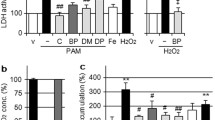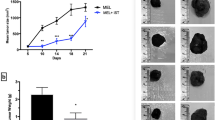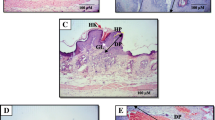Abstract
Phorbol 12-myristate 13-acetate (PMA) is a potent mouse skin tumor promoter which has been researched most intensively over the years in an attempt to understand the biochemical mechanisms involved in tumor promotion, PMA stimulates a multitude of cellular and biochemical reactions (82), Three of these, induction of ornithine decarboxylase (ODC) activity, hyperplasia and inflammation, correlate well with tumor promotion in mouse skin, and each is considered to be a necessary but insufficient event in this process (22, 27, 51, 58, 64, 70, 83) The release of metabolites of arachidonic acid (AA) is also thought to be important in view of the inhibitory effects of nonsteroidal anti-inflammatory drugs on PMA-induced ODC activity and tumor promotion (19, 48).
Preview
Unable to display preview. Download preview PDF.
Similar content being viewed by others
References
Ager, A., and J.L. Jordon (1984) Differential effects of hydrogen peroxide on indices of endothelial cell function. J. Exp. Med. 159:592–603.
Althaus, F., S.D. Lawrence, Y.Z. He, G.L. Sattler, Y. Tsukda, and H.C. Pitot (1982) Effects of altered (ADP-ribose) metabolism on expression of fetal functions by adult l3miphocytes. Nature 300:366–368.
Birnboim, H.C. (1983) Importance of DNA strand-break damage in tumor promotion. In Radioprotectors and Anticarcinogens, O.F. Nygaard and M.G. Simic, eds. Academic Press, New York, pp. 539–556.
Birnboim, H.C. (1982) DNA strand breakage in human leukocytes exposed to a tumor promoter, phorbol myristate acetate. Science 215:1247–1249.
Borek, C., W.F. Morgan, A. Ong, and J.E. Cleaver (1984) Inhibition of malignant transformation in vitro by inhibitors of poly (ADP-ribose) synthesis. Proc. Natl. Acad. Sci. USA 81:243–247.
Borek, C., and W. Troll (1983) Modifiers of free radicals inhibit in vitro the oncogenic actions of x-rays, bleomycin, and the tumor promoter 12-0-tetradecanoylphorbol-13-acetate. Proc. Natl. Acad. Sci., USA 80:1304–1307.
Bradley, M., and L. Erickson (1981) Comparison of the effects of hydrogen peroxide and X-irradiation on toxicity, mutation and DNA damage repair in mammalian cells. Biochim. Biophys. Acta 654:135–141.
Bull, A.W., N.D. Nigro, W.A. Golembieski, J.D. Crissman, and L.J. Marnett (1984) In vivo stimulation of DNA synthesis and induction of ornithine decarboxylase in rat colon by fatty acid hydroperoxides, autoxidation products of unsaturated fatty acids. Cancer Res. 44:4924–4928.
Cerutti, P.A. (1985) Prooxidant states and tumor promotion. Science 227:375–381.
Cook, H.W., and W.E.M. Lands (1976) Mechanism for suppression of cellular biosynthesis of prostaglandins. Nature 260:630–632.
Dutton, D.R., and G.T. Bowden (1985) Indirect induction of a clastogenic effect in epidermal cells by a tumor promoter. Carcinogenesis 6(9):1279–1284.
Durkacz, B.W., O. Omidiji, D.A. Gray, and S. Shall (1980) (ADP-ribose)n participates in DNA excision repair. Nature 283:593–596.
Eling, T., B. Tainer, A. Ally, and R. Warnock (1982) Separation of arachidonic acid metabolites by high pressure liquid chromatography. In Methods of Enzymology, Vol. 86, W.E.M. Lands and W.L. Smith, eds. Academic Press, New York, pp. 511–517.
Emerit, I., and P.A. Cerutti (1982) Tumor promoter phorbol 12-myristate 13-acetate induces a clastogenic factor in human lymphocytes. Proc. Natl. Acad. Sci., USA 79:7509–7513.
Emerit I., and P. Cerutti (1983) Clastogenic action of tumor promoter phorbol-12-myristate-13-acetate in mixed human leukocyte cultures. Carcinogenesis 4:1313–1316.
Emerit, I., S.H. Khan, and P.A. Cerutti (1985) Treatment of lymphocyte cultures with a hypoxanthine-xanthine oxidase system induces the formation of transferable clastogenic material. J Free Radicals in Biol and Med. l(l):51–58.
Emerit, I., and P. Cerutti (unpublished observations).
Farzaneh, F., R. Zalin, D. Brell, and S. Shall (1982) DNA strand breaks and ADP-ribosyl transferase activation during cell differentiation. Nature 300:362–366.
Fischer, S.M. (1985) Arachidonic acid metabolism and tumor promotion. In Arachidonic Acid Metabolism and Tumor Promotion, S.M. Fischer and T.J. Slaga, eds. Martinus Nijhoff Publishing, pp. 22–47.
Fischer, S.M., and L.M. Adams (1985) Suppression of tumor promoter-induced chemiluminescence in mouse epidermal cells by several inhibitors of arachidonic acid metabolism. Cancer Res. 45:3130–3136.
Friedman, J., and P. Cerutti (1983) The induction of ornithine decarboxylase by phorbol 12-myristate 13-acetate or by serum is inhibited by antioxidants. Carcinogenesis 4:1425–1427.
Furstenberger, G., and F. Marks (1985) Prostaglandins, epidermal hyperplasia and skin tumor promotion. In Arachidonic Acid Metabolism and Tumor Promotion, S.M. Fischer and T.J. Slaga, eds. Martinus Nijhoff Publishing, pp. 50–72.
Goldstein, B.D., G. Witz, M. Amoruso, D.S. Stone, and W. Troll (1981) Stimulation of human polymorphonuclear leukocyte superoxide anion radical production by tumor promoters. Cancer Lett. 11:257–262.
Goldstein, B.D., G. Witz, M. Amoruso, and W. Troll (1979) Protease inhibitors antagonize the activation of pol3miorphonuclear leukocyte oxygen consumption. Biochem. Biophys. Res. Commun. 88:854–860.
Goldstein, B., G. Witz, J. Zimmerman, and C. Gee (1983) Free radicals and reactive oxygen species in tumor promotion. In Oxy Radicals and their Scavenger Systems, Vol. II, Cellular and Medical Aspects, R.A. Greenwald and G. Cohen, eds. Elsevier, New York, pp. 321–325.
Hartley, J.A., N.W. Gibson, L.A. Zwelling, and S.H. Yuspa (1985) Strand breaks in mouse epidermal DNA are associated with phorbol ester induced differentiation. Proc. Am. Assoc. Cancer Res. 26:42.
Hecker, E. (1978) Structure-activity relationships in diterpene esters irritant and cocarcinogenic to mouse skin. In Carcinogenesis—A Comprehensive Survey, Vol. II, Mechanisms of Tumor Promotion and Cocarcinogenesis, T.J. Slaga, A. Sivak, and R.K. Boutwell, eds. Raven Press, New York, pp. 11–48.
Hemler, M.E., H.W. Cook, and W.E.M. Lands (1979) Prostaglandin biosynthesis can be triggered by lipid peroxides. Arch. Biochem. Biophys. 193(2):340–345.
Hemler, M.E., and W.E.M. Lands (1980) Evidence for a peroxide-initiated free-radical mechanism of prostaglandin biosynthesis. J. Biol. Chem. 255(13):6253–6261.
Holland, J.M., E.H. Perkinds, and L.C. Gipson (1977) Resistance of germ free athymic nude mice to two-stage epidermal carcinogenesis. Proc. Am. Assoc. Cancer Res. 18:10.
Iwashita, S., and C. Fox (1984) Epidermal growth factor and potent phorbol tumor promoters induce epidermal growth factor receptor phosphorylation in a similar but distinctively different manner in human epidermoid carcinoma A431 cells. J. Biol. Chem. 259:2559–2567.
Jacobson, E.L., K.M. Antol, H. Juarez-Salinas, and M.K. Jacobson (1983) Poly (ADP-ribose) metabolism in ultraviolet-irradiated human fibroblasts. J. Biol. Chem. 258:103–107.
Johnstone, A.P., and G.T. Williams (1982) Role of DNA breaks and ADP-ribose transferase activity in eukaryotic differentiation demonstrated in human lymphocytes. Nature 300:368–370.
Kensler, T.W. (personal communication).
Kensler, T.W., and M.A. Trush (1984) Role of oxygen radicals in tumor promotion. Environ. Mutag. 6:593–616.
Kensler, T.W., D.M. Bush, and W.J. Kozumbo (1983) Inhibition of tumor promotion by a biomimetic superoxide dismutase. Science 221:75–77.
Kensler, T.W., and M.A. Trush (1983) Inhibition of oxygen radical metabolism in phorbol ester-activated polymorphonuclear leukocytes by antitumor-promoting copper complex with superoxide dismutase-mimetic activity. Biochem. Pharmacol. 32(22):3485–3487.
Kidwell, W.R., and M.G. Mage (1976) Changes in poly (adenosine diphosphate ribose) and poly (adenosine diphosphate) polymerase in synchronous Hela cells. Eur. J. Biochem. 15:1213–1217.
Klein-Szanto, A.J.P. and T.J. Slaga (1982) Effects of peroxides on rodent skin: Epidermal hyperplasia and tumor promotion. Invest. Derma. 79:30–34.
Kozumbo, W.J., D. Muhlematter, A. Jorg, I. Emerit, and P.A. Cerutti (1985) Release of membrane lipids from human monocytes stimulated by the tumor promoter phorbol-12-myrlstate--13-acetate (submitted for publ.).
Kozumbo, W.J., J.L. Seed, and T.W. Kensler (1983) Inhibition by 2(3)-tert-butyl-4-hydroxyanisole and other antioxidants of epidermal ornithine decarboxylase activity induced by 12-0-tetradecanoylphorbol-13-acetate. Cancer Res, 43:2555–2559.
Kozumbo, W.J., M.A. Trush, and T.W. Kensler (1985) Are free radicals involved in tumor promotion? Chem. Biol. Interact. 40:199–209.
Kun, E., E. Kirsten, G.E. Milo, P. Kurian, and H.L. Kumari (1983) Cell cycle-dependent intervention by benzamide of carcinogen-induced neoplastic transformation and in vitro poly ADP-ribosylation of nuclear proteins in human fibroblasts. Proc. Natl. Acad. Sci., USA 80:7219–7223.
Lewis, J.G., and D.O. Adams (1985) Induction of 5,6-ring-saturated thinnine bases in NIH-3T3 cells by phorbol ester-stimulated macrophages Role of reactive oxygen intermediates. Cancer Res. 45:1270–1275.
Lupulescu, A. (1984) Tumorigenic potential of endoperoxide analogs. Experientia 40:209–211.
Marnett, L.J. (personal communication).
Michelson, A.M., K. Puget, P. Durosay, and A. Rosselet (1980) Penetration of erythrocytes by superoxide dismutase. In Biological and Clinical Aspects of Superoxide and Superoxide Dismutase, W.H. Bannister and J.V. Bannister, eds. Elsevier, New York, pp. 348–366.
Nakadate, T., S. Yammamoto, M. Ishii, and R. Kato (1982) Inhibition of 12-0-tetradecarioylphorbol-13-acetate-induced epidermal ornithine decarboxylase activity by lipooxygenase inhibitors: Possible role of product(s) of lipoxygenase pathway. Carcinogenesis 3:1411–1414.
Nagasawa, H., and J.B. Little (1981) Factors influencing the induction of sister chromatid exchanges in mammalian cells by 12-0-tetradecanoyl-phorbol-13-acetate. Carcinogenesis 2:601–607.
Nakamura, Y., N.H. Colburn, and T.D. Gindhart (1985) Role of reactive oxygen in tumor promotion: Implication of superoxide anion in promotion of neoplastic transformation in JB-6 cells by TPA. Carcinogenesis 6:229–235.
O’Brien, T.G. (1976) The induction of ornithine decarboxylase as an early, possibly obligatory, event in mouse skin carcinogenesis. Cancer Res. 36:2644–2653.
Ochi, T., and P.A. Cerutti (unpublished observations).
Patskan, G., and C. St. Baxter (1985) Specific stimulation by phorbol esters of the phosphorylation of histones H2B and H4 in murine lymphocytes. Cancer Res. 45:667–672.
Pederson, T.C., and S.D. Aust (1973) The role of superoxide and singlet oxygen in lipid peroxidation promoted by xanthine oxidase, Biochem. Biophys. Res. Commun. 52:1071–1078.
Perchellet, J.P., M.D. Owen, T.D. Posey, D.K. Orten, and B.A. Schneider (1982) Inhibitory effects of glutathione level-raising agents and D-tocopherol on ornithine decarboxylase induction and mouse skin tumor promotion by 12-0-tetradecanoylphorbol-13-acetate, Carcinogenesis 6: 567–573.
Rossman, T.G., and W. Troll (1980) Protease inhibitors in carcinogenesis, possible sites of action. In Modifiers of Chemical Carcinogenesis, Vol. 5, T.J. Slaga, ed. Raven Press, New York, pp. 127–143.
Scher, W., and C. Friend (1978) Breakage of DNA and alterations in folded genomes by inducers of differentiation in Friend erythroleukemia cells. Cancer Res. 38:841–849.
Schmidt, R., W. Adolf, A. Marston, H. Roser, B. Sorg, H. Fujiki, T. Sugimura, R.E. Moore, and E. Hecker (1983) Inhibition of specific binding of 3H phorbol-12,13~dipropionate to an epidermal fraction by certain irritants and irritant promoters of mouse skin. Carcinogenesis 4:77–81.
Shamberger, R.J. (1972) Increase of peroxidation in carcinogenesis. J. Natl. Cancer Inst. 48(5):1491–1497.
Singh, N., G. Poirier, and P. Cerutti (1985) Tumor promoter phorbol-12-myristate-13-acetate induces poly (ADP)-ribosylation in fibroblasts. EMBO J. 4:1491–1494.
Singh, N., G. Poirier, and P. Cerutti (1985) Tumor promoter phorbol-12-myristate-13-acetate induces poly ADP-ribosylation in human monocytes. Biochem. Biophys. Res. Commun. 126:1208–1214.
Singh, N., and P.A. Cerutti (1985) Poly ADP-ribosylation of histones in tumor promoter phorbol-12-myristate-13-acetate treated mouse embryo fibroblasts C3H10T1/2 (submitted for publ.).
Singh, N., Y. Leduc, G. Poirier, and P. Cerutti (1985) Non-histone chromosomal protein acceptors for poly ADP-ribose in phorbol-12-myristate-13-acetate-treated mouse embryo fibroblasts C3H10T1/2. Carcinogenesis (in press).
Slaga, T.J., S.M. Fischer, A. Viaje, D.L. Berry, W.M. Bracken, S. Le Clerc, and D.R. Miller (1978) Inhibition of tumor promotion by antiinflammatory agents: An approach to the biochemical mechanism of promotion. In Carcinogenesis, Vol. 2, Mechanisms of Tumor Promotion and Cocarcinogenesis, T.J. Slaga, A. Sivak, and R.K. Boutwell, eds. Raven Press, New York, pp. 173–195.
Slaga, T.J., V. Solanki, and M. Logani (1983) Studies on the mechanisms of action of antitumor promoting agents: Suggestive evidence for the involvement of free radicals in promotion. In Radioprotectors and Anticarcinogens, O.F. Nygaard and M.G. Simic, eds. Academic Press, New York, pp. 471–485.
Slaga, T.J., A.J.P. Klein-Szanto, L.L. Triplett, L.P. Yotti, and J.E. Trosko (1981) Skin tumor-promoting activity of benzoyl peroxide, a widely used free radical-generating compound. Science 213:1023–1025.
Smith, M.T., H. Thor, S.A. Jewell, G. Bellomo, M.S. Sandy, and S. Orrenius (1984) Free radical-induced changes In the surface morphology of isolated hepatocytes. In Free Radicals in Molecular Biology, Aging and Disease, D. Armstrong, R.S. Sohal, R.G. Cutler, and T.F. Slater, eds. Raven Press, New York, pp. 103–118.
Solanki, V., R.S. Rana, and T.J. Slaga (1981) Diminution of mouse epidermal superoxide dismutase and catalase activities by tumor promoters. Carcinogenesis 2:1141–1146.
Srinivas, L., and N.H. Colburn (1984) Preferential oxidation of cell surface sialic acid by periodate leads to promotion of transformation in JB-6 cells. Carcinogenesis 5:515–519.
Suganuma, M., H. Fujiki, T. Tomoko, C. Cheuk, R.E. Moore, and T. Sugimura (1984) Estimation of tumor-promoting activity and structure-function relationships of aplysiatoxins. Carcinogenesis 5:315–318.
Takayma, S., M. White, V. Lauris, and C. Kuhn (1984) Phorbol esters modulate insulin receptor phosphorylation and insulin action in cultured hepatoma cells. Proc. Natl. Acad. Sci., USA 81:7797–7801.
Tanigawa, Y., A. Kitamura, M. Kawamura, and M. Shimoyama (1978) Effect of poly (ADP-ribose) formation on DNA synthesis in chick-embryo-liver nuclei. Eur. J. Biochem. 92:261–269.
Taylor, L., M.J. Menconi, and P. Polgar (1983) The participation of hydroperoxides and oxygen radicals in the control of prostaglandin synthesis. J. Biol. Chem. 258(11):6855–6857.
Terada, M., U. Nudel, E. Fibach, R.A. Rifkind, and P.A. Marks (1978) Changes in DNA associated with induction of erythroid differentiationby dimethyl sulfoxide in murine erythroleukemia cells. Cancer Res. 38:835–840.
Thomas, M.J., S. Mehl, and W.A. Pryor (1978) The role of the superoxide anion in the xanthine oxidase-induced autoxidation of linoleic acid. Biochem. Biophys. Res. Commun. 83:927–932.
Verma, A.K., C.L. Astendel, and R.K. Boutwell (1980) Inhibition by prostaglandin synthesis inhibitors of the induction of epidermal ornithine decarboxylase activity, the accumulation of prostaglandins, and tumor promotion caused by 12-0-tetradecanoylphorbol-13-acetate. Cancer Res. 40:308–315.
Verma, A.K., T.J. Slaga, P.W. Wertz, G.C. Mueller, and R.K. Boutwell (1980) Inhibition of skin tumor promotion by retinoic acid and its metabolites 5,6-epoxyretinoic acid. Cancer Res. 40:2367–2371.
Weitberg, A.B., S.A. Weitzman, E.P. Clark, and T.P. Stossel (1985) Effects of antioxidants on oxidant-induced sister chromatid exchange formation. J. Clin. Invest. 75:1835–1841.
Weitberg, A.B., S.A. Weitzman, M. Destrempes, S.A. Latt, and T.P. Stossel (1983) Stimulated human phagocytes produce cytogenetic changes in cultured mammalian cells. New Eng. J. Med. 308:26–30.
Weiss, S.J., A.F. Lobuglio, and H.B. Kessler (1980) Oxidative mechanisms of monocyte-mediated cytotoxicity. Proc. Natl. Acad. Sci., USA 77:584–587.
Weitzman, S.A., and T.P. Stossel (1982) Effects of oxygen radical scavengers and antioxidants on phagocyte-induced mutagenesis. J. Imm. 128:2770–2772.
Yuspa, S.H. (1984) Mechanisms of tumor promotion. In Tumor Promotion and Carcinogenesis In Vitro (“Mechanisms of Tumor Promotion,” Vol. 3), T.J. Slaga, ed. CRC Press, Boca Raton, Florida, pp. 1–11.
Yuspa, S.H., U. Lichti, T. Ben, E. Patterson, and H. Hennings (1976) Phorbol-esters stimulate DNA synthesis and ornithine decarboxylase activity in mouse epidermal cell cultures. Nature 262:402–404.
Yuspa, S.H., T. Ben, H. Hennings, and U. Lichti (1982) Divergent responses in epidermal basal cells exposed to the tumor promoter 12-0-tetradecanoylphorbol-13-acetate. Cancer Res. 42:2344–2349.
Zimmermann, R., and P. Cerutti (1984) Active oxygen acts as a promoter of transformation in mouse embryo C3H10T1/2C18 fibroblasts. Proc. Natl. Acad. Sci., USA 81:2085–2087.
Author information
Authors and Affiliations
Editor information
Editors and Affiliations
Rights and permissions
Copyright information
© 1986 Plenum Press, New York
About this chapter
Cite this chapter
Kozumbo, W.J., Cerutti, P.A. (1986). Antioxidants as Antitumor Promoters. In: Shankel, D.M., Hartman, P.E., Kada, T., Hollaender, A., Wilson, C.M., Kuny, G. (eds) Antimutagenesis and Anticarcinogenesis Mechanisms. Basic Life Sciences, vol 39. Springer, Boston, MA. https://doi.org/10.1007/978-1-4684-5182-5_43
Download citation
DOI: https://doi.org/10.1007/978-1-4684-5182-5_43
Publisher Name: Springer, Boston, MA
Print ISBN: 978-1-4684-5184-9
Online ISBN: 978-1-4684-5182-5
eBook Packages: Springer Book Archive




